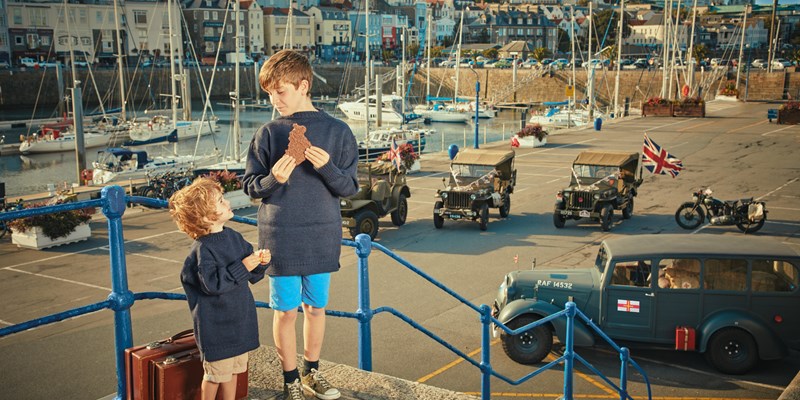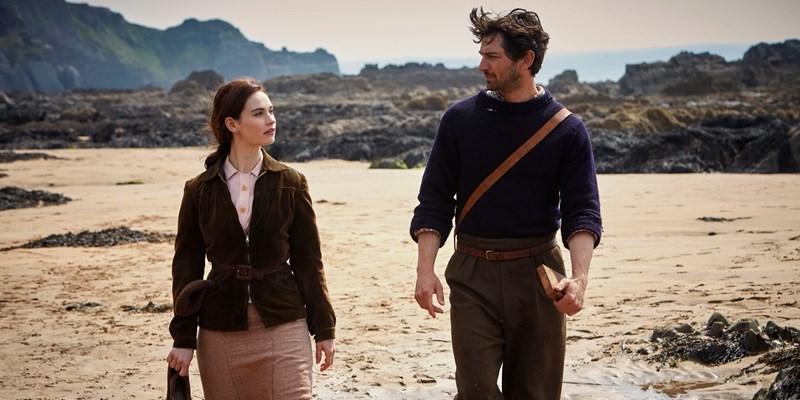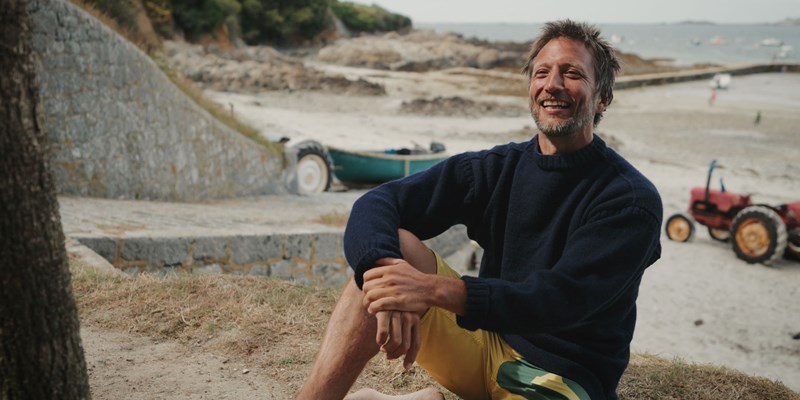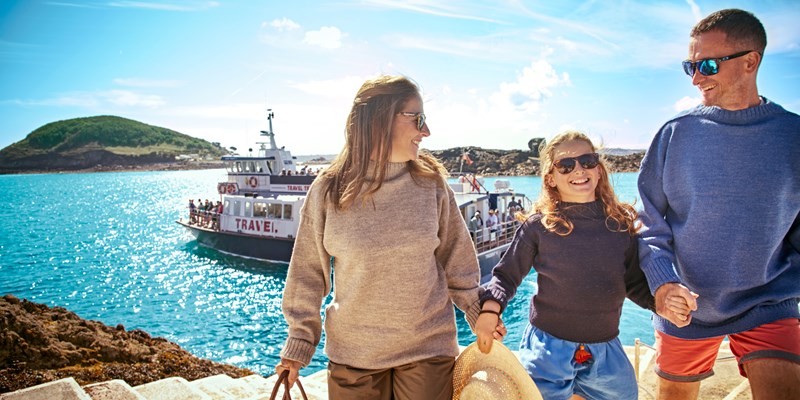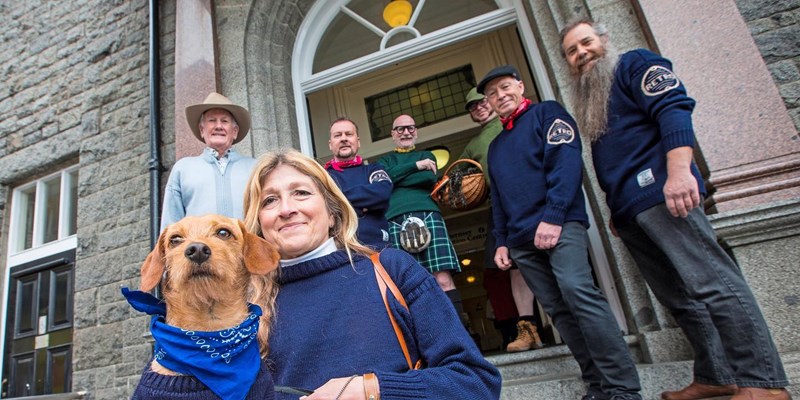The guernsey jumper (known by islanders as simply 'a guernsey') is a classic fisherman's sweater, most often produced in a sailing-inspired navy colour. Made using 100% wool with a distinctive design on its shoulders and seams, the guernsey is a unisex garment that has been beloved for centuries.
From the knitting industry's beginnings in the 16th Century to modern re-imaginings of the jumper by local makers, the guernsey has a rich history.
Here’s everything you need to know about this iconic piece of island heritage.
Guernsey’s knitting industry
To understand the history of the guernsey, we first need to discuss the legacy of the knitting industry on our islands. Started back in the 1500s, the knitting industry first produced garments for commercial sale including stockings and ‘undergarments called Guernsey frocks’. Using a special worsted wool, they were uncommonly soft whilst still providing the warmth of wool.
These guernsey stockings were so popular (despite being a luxury item) that they were worn by royalty during this time, including Elizabeth I and Mary Queen of Scots. Mary Queen of Scots even wore a pair of guernsey-patterned stockings at her execution.
The industry was so large that in the 1680s out of the 14,000 strong population, 6,000 people were employed as knitters! This led to there being not enough workers in food production and so rumour has it that men were banned from knitting during daylight hours to encourage them to go back to work on land and sea. We know this happened in Sark and suspect it happened in Guernsey too.
By the mid-1700s the industrial revolution was taking place, and hand-knitted stockings couldn’t compete on price with factory-produced garments. Fewer and fewer knitters were required commercially, and so their attention turned to providing warm garments for sea workers; who were increasing in numbers following the boom of ‘privateering’ in the late 1600s.
(Source: Caro Drake, ‘guernsey with a small g’)
Pictured above: A still from the 2018 film The Guernsey Literary and Potato Peel Pie Society
When was the guernsey jumper created?
The guernsey jumper was first documented under various names including ‘guernsey jacket’ and ‘guernsey frock’ in the 1800s, though it was likely made for many years before. Handmade by local women, they were primarily made for fishermen and coastal workers who needed a garment that was able to withstand wind, rain and seaspray whilst also allowing for freedom of movement.
The guernsey is made with 100% worsted wool, a strong, high-quality yarn with long fibres, that is naturally moisture-repellent. When knitted at a tight gauge, the fabric becomes almost windproof, and so can keep the wearer dry and warm for longer while facing the elements.
Each element of the jumper construction is important, with the original diamond shape around the underarm allowing for ease of movement, and particular stitches used to represent different parts of coastal life: “ribbing at the top of the sleeve, to mirror a sailing ship's rope ladder; a garter stitch panel depicting breaking waves and stitching on the sweater shoulders representing pebbles, stones and sand.” (Guernsey Woollens).
Families would often knit variations on the traditional pattern, which would become a way to recognise the jumper if it ever became lost.
It is estimated that it would take an experienced knitter 80 hours to hand-knit a guernsey. Records show that the last professional handknitter on our Islands, Mrs Margaret Le Lacheur could supply a finished jumper to a store in town in just 14 days! (Source: Carol Toms via Caro Drake).
Pictured above: Ambassador Chris Harvey in his guernsey
Gaining global popularity & the ‘gansey’
The guernsey was so successful that its popularity began reaching beyond the Channel Islands, becoming the go-to garment for coastal workers across the British Isles.
There is even a record of a recommendation of the jumper for naval troops from Admiral Nelson in 1804 where he declared the ‘guernsey jacket’: “the best and most valuable slops [seaman's clothes] that ever were introduced into the service…it would not be too many to send out one for every seaman in the fleet.” (Source: James Marr via Caro Drake).
As the adoption of the jumper spread across Britain and the rest of the world, the word ‘guernsey’ sometimes became ‘gansey’, which is now synonymous with a classic fisherman’s jumper. A variety of styles have appeared over the centuries, with different stitch patterns and textures, but you’ll still find the original guernsey produced on our islands today.
Guernseys during WWII
With modern alternatives on the market, the guernsey was slowly disappearing in the early 1900s. But when war broke out in 1939, an organisation called ‘Guernsey for Seamen’ was created by a group of local ladies. Their goal was to knit guernseys for all local sailors in the Navy, and between December 1939 and the beginning of the occupation in June 1940, 102 guernseys were produced. As well as being gratefully received out at sea, this initiative reignited islanders’ love for the traditional jumper.
On-Island production
After being handmade by individuals for many years, several local companies began commercial production of our beloved guernsey in the 20th century. Incorporating traditional techniques, they have brought the jumper to a new audience.
Across our islands you’ll find three producers of guernsey jumpers: Le Tricoteur, Guernsey Woollens and Channel Jumpers (Alderney). As well as creating the classic guernsey, new innovations have allowed for versions including zippers, crew necks, cardigans and more.
Image credit above: Guernsey Woollens
Guernsey Woollens have been making jumpers “with loving care” for over 40 years. Each piece is produced ‘in the round’ using modern knitting equipment, meaning it is seamless and strong. Their traditional jumpers are also reversible front to back, and Guernsey Woollens recommend alternating which side you wear as the front to get even more longevity from your guernsey.
As well as classic 100% British wool guernseys, you can find unisex variations including cotton jumpers, v-necks, crew necks, arans, cardigans and children’s sweaters.
Visit their website at guernseywoollens.com or visit their workshop in St Sampson.
Image credit above: Le Tricoteur
Le Tricoteur started production in 1964 after its founder Robert’s guernsey was highly admired on his 1963 trip around the USA. In the late 70's during their peak production time there were around 400 hand knitters and 100,000 garments made a year! Robert’s second-cousin once removed, Rachael, is now the proud owner of the business, who still finishes their garments by hand with a team of expert knitters.
You can visit Le Tricoteur at their factory and store on the west coast of Guernsey where you’ll find classic, zipped, cropped and kids guernseys.
View their website at letricoteur.co
Channel Jumpers are based in Alderney, first established in 1976 with the goal of reviving the traditional alderney sweater which had not been produced since WWI and establishing a knitting industry on the island. During royal visits to Alderney, Channel Jumpers have gifted a range of guernseys to the Royal Family - ensuring the link between the garment and monarchy continues to this day.
They produce a range of unisex guernseys in the classic design, as well as their own alderney sweater.
Browse the range at channeljumper.com or pay them a visit at their store by Braye Harbour.
Guernseys today & 'Wear A Guernsey Day'
Guernsey’s are still worn across our Islands today, and jumpers remain a key part of sailing clothing across the world, with the RNLI having taken the guernsey as part of their uniform. You’ll sometimes see guernseys in cinema too - they’ve featured in ‘Tinker, Tailor, Soldier, Spy’, ‘Swallows and Amazons’ and of course ‘The Guernsey Literary and Potato Peel Pie Society’.
With a 100% wool base, guernseys make an excellent sustainable garment which can last generations. Guernsey's can be purchased online and on our Islands - stop by our producers' workshops for a fascinating insight into this iconic jumper, or check in local stores such as Health Connections and Land of Green Ginger in the Market Square of St Peter Port to find your piece of our Islands to take home.
Wear a Guernsey Day 2023
Each year, we invite guernsey-lovers across the world to celebrate the garment with Wear A Guernsey Day, this year taking place on Thursday 16th November. Hosted by local maker Guernsey Woollens, the event also raises money for the local RNLI.
For those on-Island, don your guernsey and head to the Guernsey Information Centre between 10am - 4pm, browse the stalls from various guernsey producers on our Islands and enter the photo competition. Traditional Guernsey dishes including Bean Jar (a local bean stew) and Gâche Mélée (an apple fruit loaf) will also be available.
For those off-Island you can still participate by wearing your guernsey wherever you are in the world and sharing on social media with #WearAGuernseyDay or #WAGD.
Sources:
Le Tricoteur
Guernsey Woollens
Channel Jumpers
Caro Drake & The Guernsey Tapestry ‘guernsey with a small g’.



